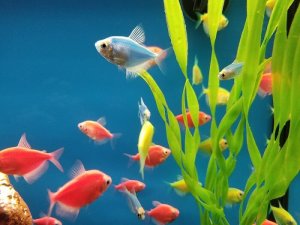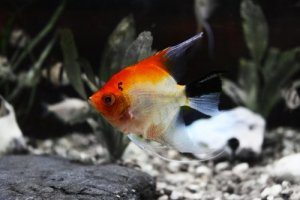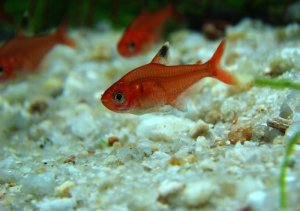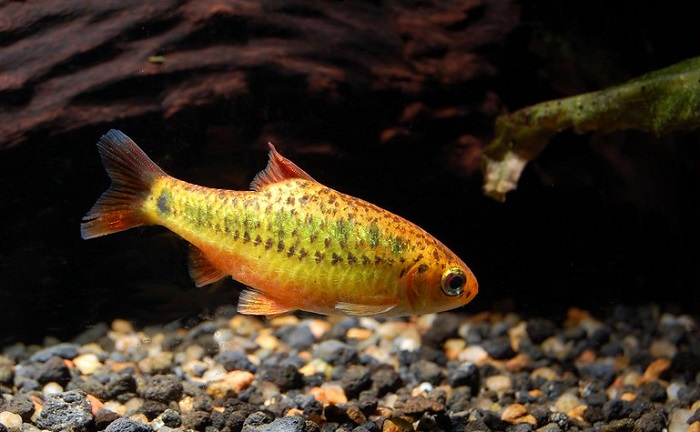
The Gold Barb, or as it’s also known the Half-Striped Chinese Barb, is a freshwater aquarium fish that boasts a gorgeous yellow color. But did you know that in their natural habitat, they have a green tint, which is very rare in the aquarium trade? The Freshwater Tropical fish can withstand slightly colder water conditions and is a notorious bottom and middle-dwelling fish. As it has a semi-aggressive nature, tank mates will have to be chosen with care.
Gold Barbs are schooling fish that do well in communal tanks, though they must be kept in groups of at least 6 fish. Because of the smaller size of the Gold Barb, they can easily be kept in communal tanks with other peaceful smaller fish species, which we will discuss in further detail.
Breed Overview
| Origin | Southeast Asia. |
| Lifespan | 3 – 5 years. |
| Size | 8 inches to 3 inches (7cm-8cm). |
| Colors | Yellow-Green, Gold, and Albino. |
| Food | Omnivore |
| Tank Size | 20-30 gallons. |
| Temperament | Peaceful, can be semi-aggressive. |
| Water Temperature | 65°F to 78°F (18°C to 26°C). |
| Water pH | A pH of between 6.0 and 8.0 is suitable. |
| Difficulty Level | Easy, and ideal for Beginners. |
Species Summary
The Gold Barb or Chinese Barb, is a Cyprinid species of fish that is native to the Red River Basin In Southeast Asia, whereas the natural variant has more of a greenish tint in color, the captive-bred Gold Barb has a golden color. In General, Gold Barbs are quite active, and semi-aggressive fish that school, and do well in a community tank as we have mentioned.
You will notice that the males of this species have a high arched back and short pair of Barbels in their upper jaw and the corners of their mouths. The females have a much rounder belly and are bulkier than males.
Color Variations
You will notice that Gold Barb males have black patches along the sides of their bodies, and they have a much more pronounced vertical stripe than females. Males have a reddish brown back, with a yellow-green, metallic side color, and a golden belly that turns white or more yellow during spawning. Females are relatively similar, yet quite dull in coloring.
The only other color Variant of the Gold Barb so far is the Albino variant, which has no black markings. In the 1990’s Flesh colored pink specimens appeared, and later tri-Colored variants, such as black, yellow, and pink.
Gold Barb Fish Size And Lifespan
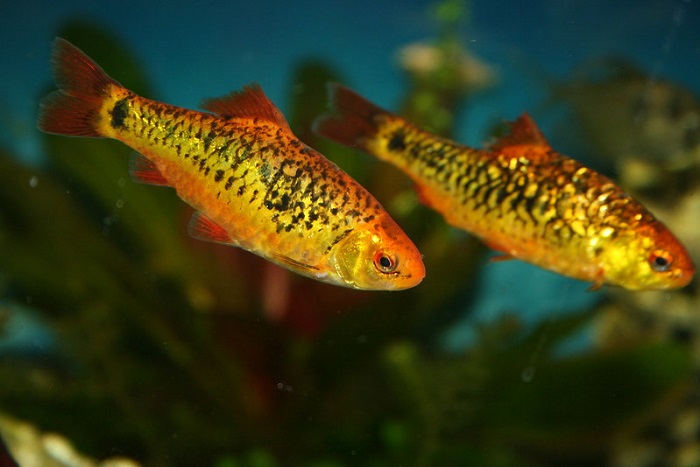
The Gold Barb is a smaller Barb species that usually grows up to around 2.8 inches to 3 inches (7cm-8cm). They have a lifespan of three years, though Gold Barbs that are cared for exceptionally well have reached up to 5 years. Thus, with the right diet and good water conditions, you may enjoy your Gold Barb for a few years more.
Temperament And Behaviour
The Gold Barb is arguably semi-aggressive, though it is sometimes portrayed as a peaceful fish. If you keep your Gold Barbs in groups of six or more fish with suitable-sized peaceful fish, there should not be any issues. However, they are known to occasionally nip at the fins of other fish and to destroy plants and decorations in the tank should they become stressed or unhappy.
General Care
First of all, and crucially, just to mention again, Gold Barbs are schooling fish and must be kept in groups of six or more fish, no less. They are small, thus easy to add to a communal tank, or even to be kept in a smaller tank on their own.
Gold Barb are Omnivores and enjoy a varied diet of meat and plant-based foods. Gold Barb enjoy soft, and slightly acidic water, and their tank should always be kept at optimal conditions, which we will discuss in more detail.
Setting Up A Communal Tank
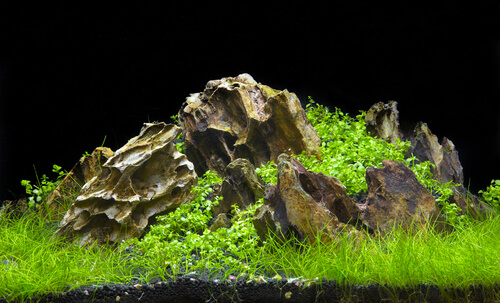
You will need to set up a tank for at least 6 Gold Barb and take into account other species companions if you will be having any. Gold Barb are tropical fish that enjoy cooler water with a slight current, plenty of plants, and open spaces for swimming.
Tank Size
The minimum tank size for six Gold Barb is 20 gallons. If you are adding more tank mates or more Barbs you will need a larger tank.
Water Parameters
Gold Barb luckily loves cooler water temperatures and you can keep them in an unheated tank. They enjoy soft slightly acidic water, with a current that is moderate, which is similar to their natural habitat.
- Temperature – Gold Barbs will thrive in lower temperatures, and are generally not fussy with water temperatures, anything in the range of temperature range of 65°F to 78°F (18°C to 26°C), will do.
- Lighting – As most Gold Barbs are found in clearer water naturally in streams and rivers, they enjoy indirect and dappled light. They should be placed in an area with indirect light. You can add a dim light to your tank, however, your fish do need an indication of day and night.
- Filtration – Because of the natural moderate current in their habitat, and their need for clear and clean water, you will need a good filter for your Gold Barb. A hang-on-back or HOB filter is usually your best choice.
- pH Levels – Gold Barb generally prefers slightly acidic water with pH levels of between 6 and 8.
- Water Hardness – Most Barb fish, especially Gold Barbs enjoy softer water, though a water hardness range of between 5 and 19 dGH is suitable.
Tank Decoration
When it comes to creating a habitat for your Gold Barbs, I would suggest something a bit more natural and similar to their natural environment, with plenty of lush plants and a few rocks. So let’s start with the best options.
- Substrate – Gold Barb does well with a thick gravel or sand substrate, you can even use Aquasoil. A darker shade substrate will show off their magnificent colors.
- Synthetic Plants – Soft fabric and silk synthetic plants can be used, however, with Barbs, in general, I prefer natural Live plants, as they can be a source of food in turn, and help to clear the water.
- Live Plants – Gold Barbs prefer to dwell in the middle and bottom area of the tank, thus they enjoy long-stemmed and flowing plants, as well as floating plants, with space in the center for free swimming. Floating Plants that you can use include; Anacharis, Dwarf Lettuce, Duckweed, Subwassertang, Crystalworth Riccai, Water Sprites, and Java Mosses. Rooted Plants with long stems such as Amazon sword Plants, Ambulias, Primrose, Hornwort, and Water Wisterias are similarly ideal. With Live Plants you have the additional benefit of the plants helping to keep your tank clean, and oxygenating the water. They are often a tasty treat for Gold Barbs to nibble on.
- Ornaments – Other decorations should be kept natural, though you can have anything of your choice. Gold Barb does not require much hiding space, but rather more swimming space. Rocks, driftwood, and a few pebbles should be sufficient ornaments for your aquarium, with one or two hiding spaces.
Introducing Your New Fish
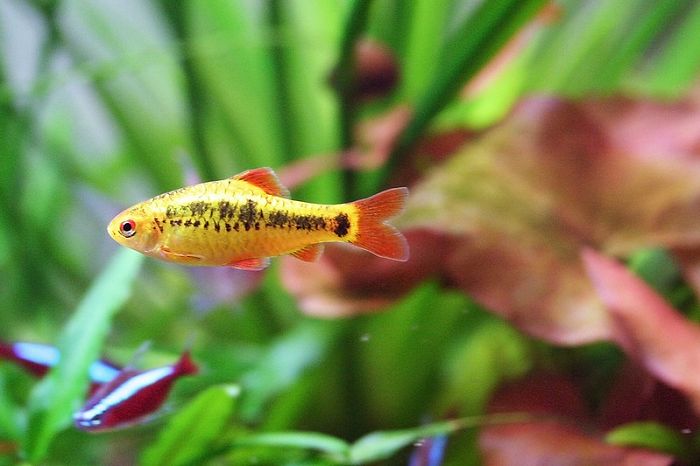
Once your tank is set up, and the water has cycled for a few days, you can test the water conditions, and if they are ideal, you can add your fish.
Gold Barbs should be chosen as a juvenile fish rather than young fry or older adults to enjoy the most out of them. You will need to choose a group of at least six Gold Barbs to be housed together.
1. Choosing A Healthy Fish
It is vital to choose fish that are in healthy condition, especially if you are adding them to a communal tank. Ensure that you get your fish from a trusted breeder or pet store, their aquariums need to be clean, with no unhealthy fish in the tank.
The Barbs that you choose must be active and lively swimming. Their fins must be in good condition with tears or damage. The body must be clear and have no white spots or brown patches. Eyes need to be clear and not have a white or milky color.
2. Adding Your Gold Barb To The Tank
There is a specific method of adding any new fish to a tank. It’s slightly easier with Gold Barbs, as they are used to cooler water temperatures. You will need to float the fish in their bag in the water for around 10 to 15 minutes. Then you can replace a cup of the water in the bag with water from the tank.
Repeat the process for about half an hour replacing the water every 10 minutes. You can now net and place your new fish in the tank, or pour them in, being careful not to allow much of the water from the bag into the tank. If you are adding Gold Barbs to a tank with other species, it is important to feed your fish first before adding new companions.
3. Selecting Tank Mates / Companions
Gold Barbs are very active, small, and reasonably peaceful, though they have been known to nip at fish with long flowing fins, and to nibble on plants in their tank. You will see that they are generally rated as semi-aggressive, though, this is circumstantial mostly.
You can keep your Gold Barbs with most other Barb species that are similar in size, as well as with smaller peaceful fish such as Tetras, Danios, and then of course some bottom feeders such as smaller Plecos, and Corydoras Catfish. Snails are likewise an excellent addition that will help to keep your tank clean.
4. Feeding Your Gold Barb Fish
Feeding Gold Barbs is relatively easy and can be quite fascinating to watch. They like variety and are omnivores demanding proteins and vegetables to thrive. They will even snack on some of the plants in their tank, given the chance.
What To Feed
With my journey with Omnivorous Smaller Barbs so far, I can highly recommend that they are fed a varied diet. They are eager feeders and do enjoy a variety of foods comprising of meat and plant-based foods, as well as quality flakes or pellets.
- Pellets And Flakes – Gold Barb require high-quality flakes or pellets and can be fed algae wafers or shrimp-based pellets.
- Live And Frozen Foods – Live and Frozen foods that Gold Barb seems to love to include; Brine Shrimp, micro worms, Mosquito Larvae, Grindal Worms, and Moina.
- Plant Material – You can occasionally feed your Gold Barbs vegetables, such as zucchini, shelled peas, spinach, or lettuce that has been blanched and cooled down first.
How To Feed
Feed your Gold Barb three times a day, of which two feeds are meals, and one is a snack in between. Feed as much as they can finish within five minutes.
Tank Maintenance
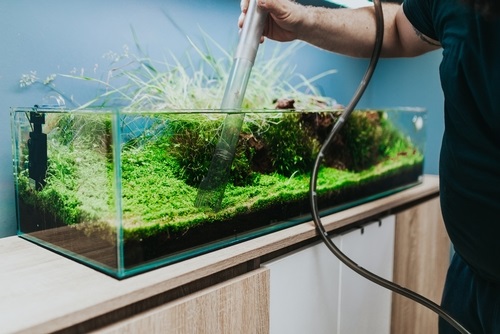
Maintaining the tank of your Gold Barbs is quite easy, which is why they are such a sought-after choice for beginner aquarists. Gold Barbs are hardy fish with very simplistic tank requirements needed to thrive. You can wipe away excess algae, clean the tank décor, and do weekly partial water changes to keep the tank conditions in top shape.
I would highly recommend a water testing kit just to ensure that the water parameters are ideal. On Wikihow you will find in-depth step-by-step instructions for tank cleaning and maintenance.
Common Pests And Diseases
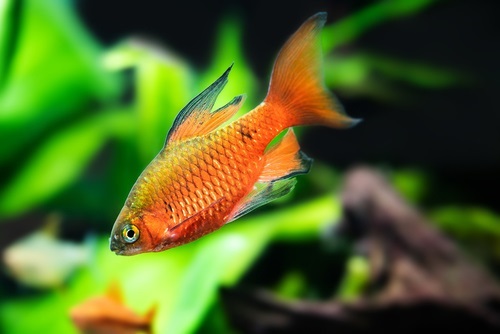
Gold Barbs are very resilient fish and with the right diet and water conditions, should not have any health issues. Though, to be on the safe side, here are a few common health issues found in most freshwater fish;
- Ich – The condition is parasitic causing white spots on the fins and near the gills of your fish. It is treated by placing the fish in a separate tank and cleaning the water daily until the cycle of the parasite is under control.
- Swim Bladder Disease – Fish have an organ called a swim bladder that helps them to stay afloat and keep upright. When you notice your Barbs starting to struggle to remain stable or laying on their sides, they likely have Swim Bladder Disease, a bacterial infection affecting this organ. Feed your Barbs Daphnia and shelled peas to help with digestion, and the fish can be treated with antibiotics.
- Fin Rot – Fin Rot is an infection that will spread from the fins of your fish to the body. The fins will show discoloration and damage caused by an infection. You will need to place the affected fish in a separate tank and treat it with antibiotics.
- Dropsy – Dropsy is a dreaded disease in fish, where few survive. The symptoms will usually be lifted scales and bloating. Many factors can instigate Dropsy, especially poor water conditions, and an unhealthy diet. Your best option is to separate your fish, keep the tank clean and use Epsom salts or antibiotics, in case of a bacterial infection.
You can follow our site “Goldfish Behavior Before Death” for more information on common health issues in freshwater fish, that likewise pertains to Gold Barbs.
Breeding Gold Barb Fish
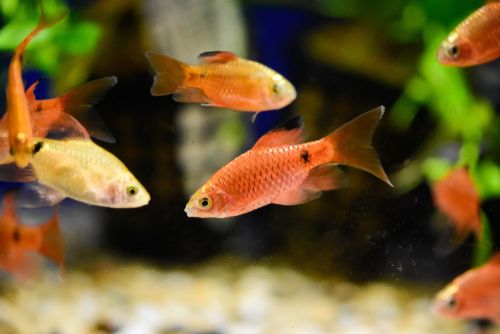
Breeding Barbs, especially Gold Barbs is similarly easy. You will need a separate breeding tank, with the same amounts of males and females that are old enough and ready for spawning. The males will be much more vivid in color and the females will be quite bulky.
Ensures plenty of plants in your breeding tank and slightly higher water temperatures. Your Barbs will spawn in the early morning, a single female laying around 100 eggs. After spawning adult fish need to be removed, as they will eat the eggs.
The eggs will hatch within a day, and the small fry will be free swimmers a day later when you can start to feed them baby brine shrimp.
Final Thoughts
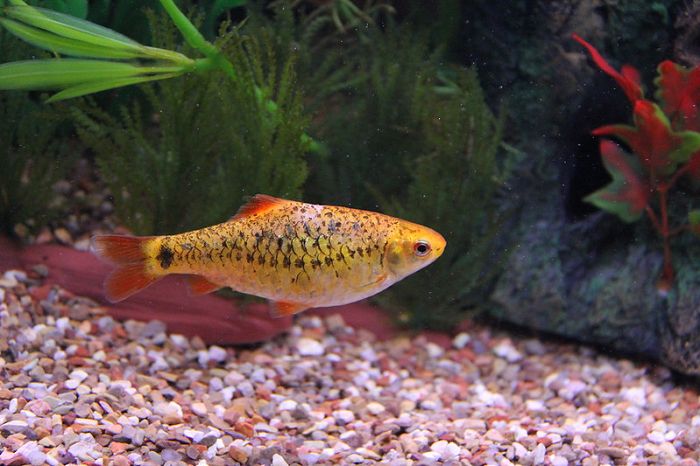
The Golden Barb is a beautifully colored fish from this species, particularly the males. It has a fascinating personality and is a brilliant choice as a communal fish, to be kept in groups. For beginners, I would highly recommend Golden Barbs as they are resilient and very easy to keep, with little fuss or health issues.


